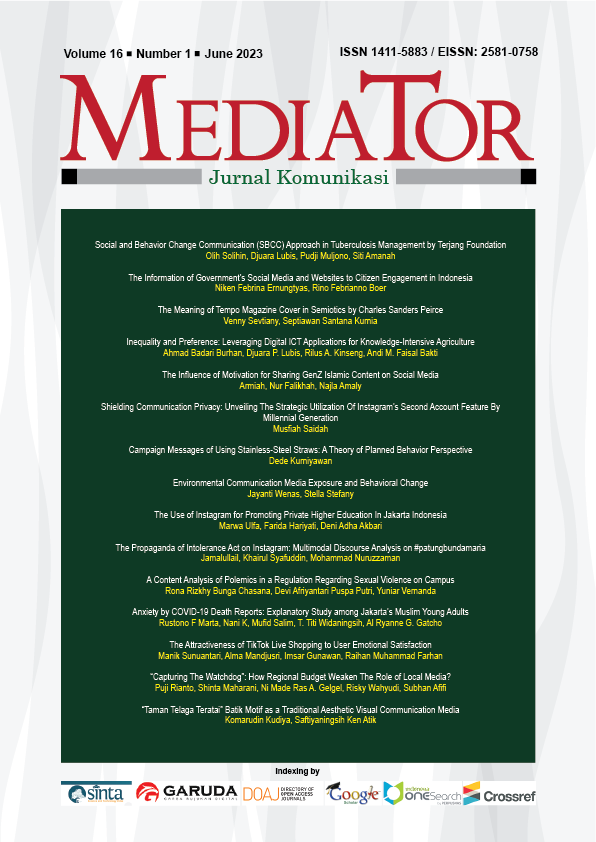“Capturing The Watchdog”: How Regional Budget Weaken The Role of Local Media?
DOI:
https://doi.org/10.29313/mediator.v16i1.2145Keywords:
political economy, local media, watchdog, local democracyAbstract
The political economy perspective suggests that the organization and financing of mass media influence media content. This research examines how the regional revenue and expenditure budget (APBD) financing has affected (the quality of) content and public communication. The study was conducted in Yogyakarta and Bali. This study uses qualitative methods. Data is collected through in-depth interviews and observations of the news. In-depth interviews were conducted with journalists, academics, and media analysts in Yogyakarta and Bali. This research found that the APBD significantly contributes as the revenue source of local media, particularly during the COVID-19 pandemic. Some media outlets even exhibit high dependency on APBD, as indicated by the sum of APBD they received. This has weakened the role of local media as a watchdog for local government while also creating a crisis for local public communication. Public communication today is predominantly filled with news emphasizing publicity rather than critical and investigative coverage of local issues. As a result, efforts to create an informed society as a prerequisite for democracy would be difficult to realize. The community’s involvement in local democracy is greatly defined by the quality of information they receive.
References
Ashraf, S. I., Soherwordi, S. H. S., & Javed, T. (2016). Herman and Chomsky’s Propaganda Model: Its Application on Electronic Media and Journalists in Pakistan. Journal of Political Studies, 23(1), 273–289.
Baggini, J. (2003). Making Sense: Filsafat di Balik Headline Berita. Teraju.
Baran, S. J., & Davis, D. K. (2000). Communication Theory: Foundations, Ferment, and Future. Wadsworth Thomson Learning.
Carson, A., & Farhall, K. (2018). Journalism Studies Understanding Collaborative Investigative Journalism in a “Post-Truth” Age. Age, Journalism Studies, 19(13), 1899–1911. https://doi.org/10.1080/1461670X.2018.1494515
Ciaglia, A. (2013). Pluralism of the system, pluralism in the system: Assessing the nature of media diversity in two European countries. International Communication Gazette, 75(4), 410–426. https://doi.org/10.1177/1748048513482262
Coleman, S. (2013). Debate on television: The spectacle of deliberation. Television and New Media, 14(1), 20–30. https://doi.org/10.1177/1527476411433520
Croteau, D., & Hoynes, W. (2006). The Business of Media: Corporate Media and Public Interest (second). Pine Forge Press.
Curran, J. (1989). Mass Media and Democracy: A Reappraisal. In J. Curran & M. Gurevitch (Eds.), Mass Media and Society (pp. 82–117). Edward Arnold.
Curran, J. (2011). Media and democracy (J. Curran (ed.); Firts). Routledge.
Dahlgren, P. (2005). Television, Public Spheres, and Civic Cultures. In J. Wasko (Ed.), A Companion to Television (pp. 411–422). Blackwell Publishing Ltd.
Dawes, S. (2014). Broadcasting and the public sphere: Problematising citizens, consumers and neoliberalism. Media, Culture and Society, 36(5), 702–719. https://doi.org/10.1177/0163443714536842
Gaines, W. C. (1998). Laporan Investigasi untuk Media Cetak dan Siaran. Institut Studi Arus Informasi (ISAI)-Kedutaan Besar Amerika Serikat.
Garnham, N. (2000). Emancipation, the Media and Modernity (1st ed.). Oxford University Press.
Garnham, N. (2011). The Handbook of Political Economy of Communication. In H. Wasko, Janet, Murdock, Graham, Sousa (Ed.), The Handbook of Political Economy of Communication. Blackwell Publishing Ltd.
Golding, P., & Murdock, G. (1992). Culture, Communications, and Political Economy. In M. G. James Curran (Ed.), Mass Media and Society (pp. 15–32). Edward Arnold.
Hardy, J. (2014). Critical Political Economy of the Media: An introduction. In Critical Political Economy of the Media: An Introduction (1st ed.). Routledge. https://doi.org/10.4324/9780203136225
Haryanto, I. (2003). “The Age of Capital”: Pers, Uang, dan Kekuasaan. MEDIATOR, 4(1), 29–32.
Heychael, M., & Dhona, H. R. (2014). Independensi Televisi Menjelang Pemilu 2014: Ketika Media Jadi Corong Kepentingan Politik Pemilik. Dewan Pers, 09(1). https://dewanpers.or.id/assets/ebook/jurnal/90271.jurnal edisi9_juni.pdf
Ispriadi, B. D. S., Putri, D. A., & Dewani, P. K. (2020). Eksistensi Media Cetak Pada Masa Pandemi Covid-19. JISIP: Jurnal Ilmu Sosial Dan Ilmu Politik, 9(2), 127–134. https://doi.org/10.33366/jisip.v9i2.2233
Julian, M. (2022). Realisasi Belanja Iklan Pemerintah dan Organisasi Politik Rp 4, 4 T di Semester I. Kontan.Co.Id. https://newssetup.kontan.co.id/news/realisasi-belanja-iklan-pemerintah-dan-organisasi-politik-rp-44-t-di-semester-i.
Kalogeropoulos, A., Svensson, H. M., Van Dalen, A., De Vreese, C., & Albæk, E. (2015). Are watchdogs doing their business? Media coverage of economic news. Journalism, 16(8), 993–1009. https://doi.org/10.1177/1464884914554167
Lestaluhu, S. (2015). Peran Media Cetak Dalam Mengawal Kebijakan Publik Di Kota Ambon. Jurnal Penelitian Komunikasi Dan Opini Publik Vol., 19(1), 1–15.
Lim, M. (2017). Klik yang Tak Memantik: Aktivisme Media Sosial di Indonesia. Jurnal Komunikasi Indonesia, 3(1). https://doi.org/10.7454/jki.v3i1.7846
Masduki, M. (2018). Public Broadcasting Reform in the Transitional Society: The Case of Indonesia. Jurnal Komunikasi Indonesia, 6(2). https://doi.org/10.7454/jki.v6i2.8916
McChesney, R. (2000). The Political Economy of Communication and the Future of the Field. Medai, Culture, & Society, 22(1), 109–116.
McChesney, R. W. (2001). Global Media, Neoliberalism, and Imperialism. Monthly Review, 52(10), 1. https://doi.org/10.14452/mr-052-10-2001-03_1
McManus, J. H. (1994). Market-Driven Journalism: Let the Citizen Beware? SAGE Publications Inc.
McNair, B. (2011). an Introduction to Political Communication (fifth). Routledge. https://doi.org/10.4324/9780203699683
Miles, M. B., Huberman, A. M., & Saldana, J. (2018). Qualitative Data Analysis (fourth). SAGE Publications Ltd.
Mosco, V. (2009). the Political Economy of Communication (2nd ed.). Sage Pub.
Murdock, G., & Golding, P. (1997). For a Political Economy of Mass Communications. In Graham Murdock and Peter Golding (Ed.), The Political Economy of the Media (pp. 3–31). SAGE Publications Inc.
O’Shaughnessy, M., & Stadler, J. (2005). Media and Society: an Introduction (third). Oxford University Press.
Okumura, N., Hayashi, K., Igarashi, K., & Tanaka, A. (2021). Japan’s media fails its watchdog role: Lessons learned and unlearned from the 2011 earthquake and the Fukushima disaster. Journalism, 22(11), 2675–2691. https://doi.org/10.1177/1464884919891270
Pedro, J. (2011). The propaganda model in the early 21st century: Part I. International Journal of Communication, 5(1), 1865–1905.
Pinto, J. (2008). Muzzling the watchdog: The case of disappearing watchdog journalism from Argentine mainstream news. Journalism, 9(6), 750–774. https://doi.org/10.1177/1464884908096244
Putra, I. G. N. (2004). Demokrasi dan Kinerja Pers Indonesia. Jurnal ILMU KOMUNIKASI, 3(2), 119–142. https://doi.org/10.24002/jik.v3i2.235
Rahayu, R. (2018). Political Interconnection in the Operation of Digital Terrestrial Free-to- Air Television Broadcasting. Policy & Governance Review, 2(1), 14. https://doi.org/10.30589/pgr.v2i1.69
Rianto, P., Rahayu, Yusuf, A., & Wahyono, B. (2014). Kepemilikan dan Intervensi Siaran (P. Rianto (ed.)). PR2Media.
Saud, M., & Margono, H. (2021). Indonesia’s rise in digital democracy and youth’s political participation. Journal of Information Technology and Politics, 18(4), 443–454. https://doi.org/10.1080/19331681.2021.1900019
Shoemaker, P. J., & Reese, S. D. (2014). Mediating the Message in the 21st Century: A Media Sociology Perspective. Routledge.
Siregar, A. E., Rahayu, Rianto, P., & Adiputra, W. M. (2014). Menakar Independensi dan Netralitas Jurnalisme dan Media di Indonesia. Dewan Pers, 09(1), 3–40. https://dewanpers.or.id/assets/ebook/jurnal/90271.jurnal edisi9_juni.pdf
Souisa, H. Y. (2020). Broadcasting paradox? A study of content diversity and ownership in contemporary Indonesian television (Issue February) [The University of Melbourne]. https://orcid.org/0000-0003-0908-7301
Sudibyo, A., & Patria, N. (2013). The Television Industry in Post-authoritarian Indonesia. Journal of Contemporary Asia, 43(2), 257–275. https://doi.org/10.1080/00472336.2012.757434
Suwana, F. (2020). What motivates digital activism? The case of the Save KPK movement in Indonesia. Information Communication and Society, 23(9), 1295–1310. https://doi.org/10.1080/1369118X.2018.1563205
Tapsell, R. (2015). Platform convergence in Indonesia: Challenges and opportunities for media freedom. Convergence, 21(2), 182–197. https://doi.org/10.1177/1354856514531527
Tapsell, R. (2019). Kuasa Media di Indonesia, Kaum Oligarki, Warga dan Revolusi Digital. Marjin Kiri.
Wahyuni, H. (2006a). Ekonomi Politik Kebijakan Penyiaran Indonesia: Aspirasi, Pilihan dan Realitas. In JKAP (Jurnal Kebijakan dan Administrasi Publik) (Vol. 10, Issue 2, pp. 149–170). https://doi.org/10.22146/jkap.8365
Wahyuni, H. (2006b). Indonesian Broadcasting Policy. Media Asia, 33(3–4), 153–161. https://doi.org/10.1080/01296612.2006.11726827
Wahyuni, H. (2016). Indonesian Broadcasting Policy The Limits of Re-regulation to Create a Democratic Broadcasting System Hermin Indah Wahyuni. Media Asia, 33(3&4), 153–161. https://doi.org/10.1080/01296612.2006.11726827
Willis, J. (2007). The Media Effect How The News Influnces Politics and Goverment (J. Scheuer (ed.); Firts). Praeger.
Yusuf, I. A. (2011). Media Lokal dalam Konstelasi Komunikasi Politik di Daerah. Jurnal Ilmu Sosial Dan Ilmu Politik, 14(3), 297–316.
Downloads
Published
Issue
Section
License
Copyright (c) 2023 Author

This work is licensed under a Creative Commons Attribution-ShareAlike 4.0 International License.























